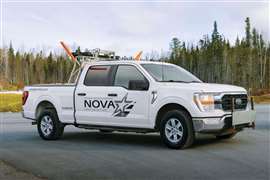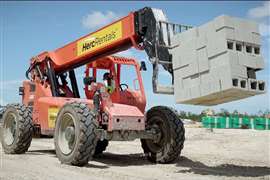Portable Power: Power struggle
12 April 2011

The latest diesel engine emission laws in Europe and the US are bringing some new features and an awful lot of cost to the compressor and generator market. Chris Sleight looks at how the industry is reacting.
The introduction of Stage IIIB and Tier 4 Interim laws in Europe and North America at the start of this year have seen new and stricter limits put on permissible emissions from diesel engines in off-highway applications. This of course covers all manner of earthmoving machines, but it also covers compressors in Europe and both compressors and generators in the US.
This has posed an enormous design challenge as Alex Persyn, product marketing manager for Doosan Portable Power in the Europe, Africa and Middle East region explained.
"The engine envelope has increased due to the addition of exhaust gas recirculation (EGR), the space claim for a diesel oxidising catalyst (DOC) or diesel particulate filter (DPF) and exhaust silencer, engine heat rejection increases of +30% to +40% requiring redesign of cooling systems and planning for currently undefined Stage IV Final technology. Not an easy task to combine resulting space claim, noise limits and customer expectations," he said.
All of this has a cost, and while it may not make a huge difference in machines like excavators that are already large, complicated and expensive, the impact on the cost of machines like compressors will be enormous. Manufacturers have told iC that the cost of a Tier 4 Interim machine, compared to the equivalent Tier 3 model will be anywhere from +30% to +45% greater.
There may be some savings in running costs, as the new generation of cleaner engines are also more efficient, but the fact remains that buying a compressor is going to get more expensive as the Tier 4 Interim and Stage IIIB laws come in.
The first wave of the legislation, which took effect from the start of this year, applied to 130 kW to 560 kW engines, which is to say the larger end of the portable power market. The start of 2012 will see 56 kW to 130 kW engines affected, followed by
37 kW to 56 kW units at the start of 2013.
According to Russ Warner, Doosan Portable Power's manager for global air products, the new laws and their price implications are already having an impact.
"We've seen some pre-buy activity because rental houses understand that they're not going to be able to increase rates in line with their acquisition costs. That motivates them to buy machines now, at the current tier level, to get them through the next few years.
"However, others are making the commitment to the technology. We've seen a strong desire to transition to the Tier 4 machines, particularly among the bigger rental houses, because of the lower emissions and they want to utilise the latest technology too. With the bigger houses, which have the staff and the mechanics and so on, it's not such a big deal. The ones that we see struggling are some of the smaller ones," he said.
Nicolas Englebert, Atlas Copco's large compressor product manager, argues that rental companies should opt for the new technology sooner rather than later. He says rental companies will benefit from having more efficient engines, as well as a smaller footprint than some alternative low-emission technologies.
He acknowledges that rental companies may be tempted to buy lower cost units until the supply is exhausted, in particular from smaller manufacturers who will be able to better utilise the flexibility allowance to continue selling old units in the US.
However, he says rental companies and large contractors will benefit from standardising their fleets with the latest equipment, giving flexibility in where the machines can be used (including demanding regions like California or Switzerland), lower overall fleet management costs, and the ability to sell environmental benefits and lower fuel costs to their customers.
"We believe that rental companies that invest in clean units will have a competitive advantage", said Mr Englebert.
But there is no doubt that the increased cost and complexity of Tier 4 Interim compressors is a concern for some buyers. This has encouraged manufacturers to think along different lines, and one of the first fruits of this is the HP750e electric portable compressor, shown by Doosan at last month's ConExpo exhibition in Las Vegas, US.
The machine is designed to be run either from mains power or a separate generator - which at first sounds like a bad idea - why use two pieces of equipment instead of one? However, the company says the lower purchase price - the 750 cfm (354 l/s) HP750e will be priced around the same level as a Tier 3 machine, rather than the +40% or so premium to a Tier 4 Interim one - combined with operating efficiencies, will make it an attractive option.
"The savings would come if you were using grid (mains) power, where we found it's significantly cheaper than diesel fuel. However, even if you're using a properly sized generator, that generator will get more energy out of the diesel fuel than a diesel compressor will.
"A direct drive compressor has inherent inefficiencies. There are strong parasitic loads, and the duty cycle is often such that you have a lot of short burst and it might idle a lot. A generator at idle is not at load, but a compressor has a load at idle, so it consumes more fuel," said Mr Warner.
A further advantage of the electric system is that it features an infinitely variable motor, which allows for soft start ups and the selection of a range of pressures and flows - all of which can be programmed into the control panel.
There are also no emissions from the unit, and it is quieter than a diesel-powered machine.
Two markets
Another effect of the new regulations in Europe and the US is that it will cause a decisive split in the global market for portable power products. The new Stage IIIB and Tier 4 Interim engines must be run on ultra low sulphur diesel - typically 15 parts per million of sulphur or less. Any higher than this and the aftertreatment systems will become clogged, which will block the exhaust and cause the engine to break down.
Ultra low sulphur fuel is only widely available in highly regulated markets such as Europe, Japan and the US. This means that the latest generation of low emission compressors and generators cannot be used outside these regions, due to the lack of availability of this sort of diesel.
To address this, global manufacturers produce two ranges of equipment, with machines for less regulated markets increasingly being manufactured locally. Atlas Copco for example has factories in China and Brazil to serve these markets.
But the fact that these machines use less sophisticated engines does not mean that they are old designs.
Mr Warner said, "When we design a new Tier 4 Interim product, we do it with a clean sheet of paper and we integrate anything we've learned into our other portfolio. We try to integrate the assembly process and the commonality of gauges and so on, so there's consistency and we can leverage our scale."
And although engine emission laws have been a big driver for manufacturers, integrating these new power units has not been the sole focus of their design efforts.
Atlas Copco's global product manager for generators, Julio Tome said, "It used to be that the most expensive component in our generators was an engine, and the second was the alternator. Now the most expensive is the engine, but the second is the base frame. That tells you a lot about the strength of our machines.
"We design our generators to be portable, and that are not damaged by frequent movement. So we reinforced the base plate. The base plate can support four times the weight of the machine. We also make sure the lifting point is at the centre of gravity."
Other factors Mr Tome cited as being important were performance, reliability, flexibility, serviceability, compactness and a good residual value.
Another popular innovation from Atlas Copco on both its generators and compressors has been its telematics system, as Mr Tome explained, "It is a web-based system that can monitor the machine's operational aspects as well as location, maintenance, performance - all the key parameters. You can also define working areas - geofences - and other things that can be set to raise alarms. It is a standard option.
"It has been a real success story. Many customers have picked it up, and it is really appreciated in the rental market."
Future
There may be obvious cost disadvantages to the latest generation of Stage IIIB/Tier 4 Interim machines, but there will also be improvements in terms of fuel efficiency, new products features and of course lower exhaust emissions. As the manufacturers have made clear, in many cases, these trickle down to compressors and generators built for any part of the world - not just highly regulated markets like Europe, Japan and the US.
And it may well be the case that new products like Doosan's electric compressor, which was born out of the perceived negative ramifications of the Tier 4 Interim laws, also find use in other parts of the world.







